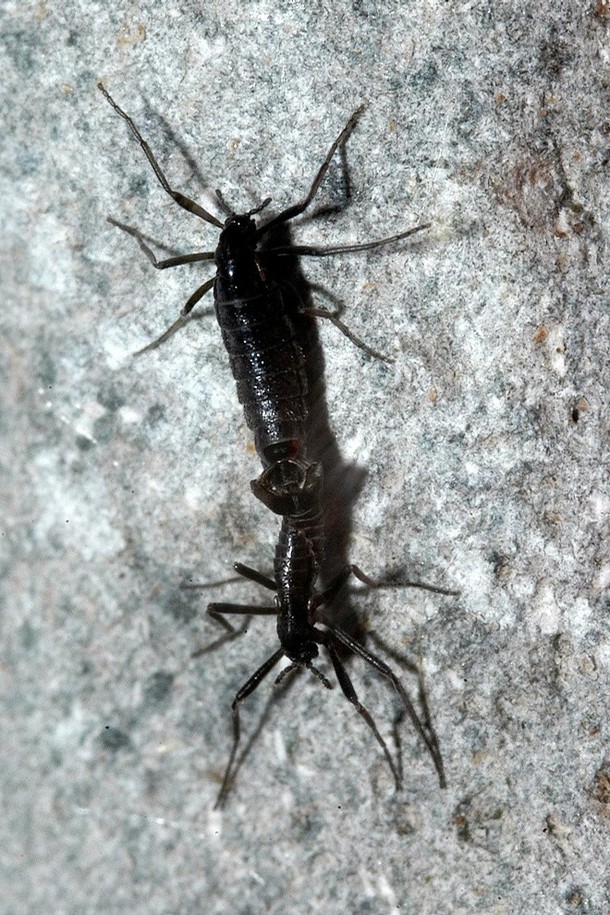
 This here on the left is the Antarctic midge - a small, flightless midge that is endemic to Antarctica. Despite being only 2-6 millimeters (0.08-0.23 in) long, it is the largest purely terrestrial animal in Antarctica, and the only insect.
This here on the left is the Antarctic midge - a small, flightless midge that is endemic to Antarctica. Despite being only 2-6 millimeters (0.08-0.23 in) long, it is the largest purely terrestrial animal in Antarctica, and the only insect.On the right is the Loblolly pine. Native to the Southern US, it is the second most common tree species in the US, and is the most commercially important tree. It can reach a height of up to 30-35 meters (98-115 ft).
At 99 megabases, the Antarctic midge has the smallest insect genome to date - smaller even than the lice genome. Compare that to the loblolly pine, with the largest genome sequenced to date, at 23.2 gigabase pairs, or 234 times larger than that of the midge! These two genomes were sequenced just this year (and are both Open Access!).
First, to clarify: genome size is not necessarily a measure of complexity. The human genome contains 3 gigabase pairs, while the mouse genome contains 2.9 gigabase pairs. Many amphibians and flowering plants have larger genomes than humans, and echinoderms (like starfish and sand dollars) have a similar sized genome as we do. Genome size generally depends on amplification, duplication, deletion, and rearrangements of DNA sequences, including transposable elements (aka jumping genes). Often, there is no selective pressure against non-active or duplicated genes, and so they remain in the genome.
That being said, there is a potential adaptation for the Antarctic midge's small genome. The continent became isolated around 33 million years ago, and its cold desert environment is generally inhospitable to most forms of terrestrial life. Antarctica does have a pretty hoppin' marine ecosystem though, so don't feel too bad for it. The Antarctic midge was first observed in the 19th century. This little bug is amazing - it is exposed to extreme temperatures, periodic desiccation, both fresh and salt water, intense UV exposure, high nitrogen concentrations from penguin and elephant seal hangouts, and the larval stage involves being encased in ice for most of the year. The adult midge is wingless as an adaptation to the high winds. After two years in the larval stage, they pupate and become adults. Then they crawl over rocks, mate, lay eggs, and die - all within 7-10 days!
Besides winglessness, these little guys have other unusual adaptations to survive in their extreme environment. They are able to withstand extreme freezing and desiccation, and have continuous (technical term: constitutive) expression of heat shock proteins (HSPs), and two antioxidant enzymes (catalase and superoxide dismutase, or SOD). Other organisms express these enzymes in response to sudden stress, but the Antarctic midge, as well as a few Antarctic fish species, do it all the time. The researchers who sequenced the genome are hoping that this information will provide insights into the genomic processes and evolution that are essential to survival in extreme climates.
The fact that this genome is so small is a bit of a surprise. There tends to be a coupling between low temperatures and large genomes, indicating that some other type of evolutionary force is keeping the midge's genome so small. The Antarctic midge's genome lacked repeats, had smaller introns, and a reduced number of transposable elements. Only about 0.12% of the genome was made of transposable elements, compared to mosquitoes and fruit flies, whose genomes are 16% and 20% transposable elements, respectively. There is strong evidence that transposable elements are derived from horizontal gene transfer, and so the authors suggest that the low levels of transposable elements in the Antarctic midge genome stem from the lack of this gene transfer in species-poor Antarctica. Further, many of the genes that are present in species such as mosquitoes - like those involved in smelling and detecting food sources - are not needed in the Antarctic midge due to limited food choices. Thus, their genome has been streamlined, keeping only the most efficient genes for survival.
On the other hand, the loblolly pine has a genome that is 79% transposable elements, with an average intron length of about 2700 base pairs. The longest intron is over 318 000 base pairs! For comparison, the Arabidopsis thaliana genome is 15.3% transposable elements. But, transposable elements alone don't account for the large size of the loblolly pine genome - it also contains over 50 000 genes, compared to over 27 000 in Arabidopsis. Further, some of this DNA is telomeric sequences - pines are known to have especially long telomeres. The loblolly pine also has a large class of genes involved in disease resistance and stress response.
So, when we compare these two genomes, the largest being 234 times larger than the smallest, we find that non-coding DNA makes up a huge factor in different genome sizes. 79% of the loblolly pine genome is made of transposable elements, compared to 0.12% for the Antarctic midge. But even more interesting, 19.4% of the 99 megabase genome of the Antarctic midge contains functional genes, while only approximately 0.21% of the loblolly pine genome is actually functional (calculated based on the number of genes and average coding sequence length, this is approximate so use with caution). That just goes to show that having a larger genome doesn't necessarily mean having a more functional one.
No comments:
Post a Comment